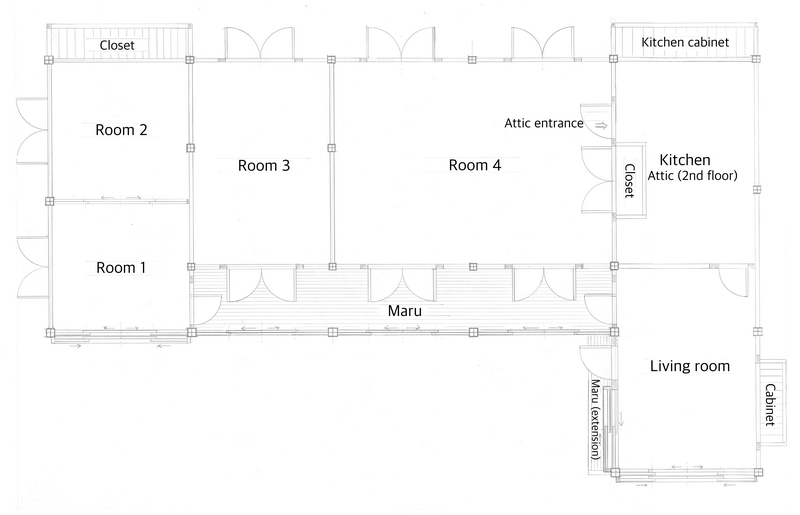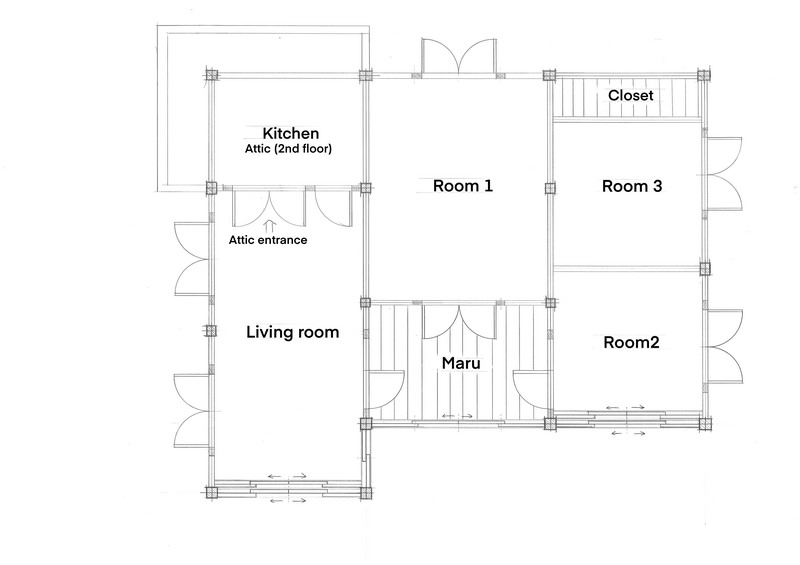Chapter 2. Floor Plans of Mass-Produced Hanok in Gwangju
By Kang Dong-su
In the first chapter, we briefly learned the background story behind the hanok houses that we can easily see in older neighborhoods of Gwangju. Those are mass-produced hanok built to solve the city’s overpopulation during the 1960–70s by many different private developers. The hanok of that era have a lot of different influences from many different cultural backgrounds, like from China, Japan, and Western culture.
After reading the last article, you might have had some interest in those hanok and maybe tried to look around older areas of Gwangju to see how they look. But a lot of hanok would probably be hidden under extension roofs or behind high walls, making it hard to find a house you can have access to. As a carpenter fixing such houses, I have gotten lots of chances to visit and see all their structures in various forms. Though many houses have been renovated over the decades, making it hard to see their original plans, I have found a few houses that have remained intact, and this has helped me find the pattern of structures and floorplans of mass-produced hanok. In this chapter, I would like to share some floorplan blueprints that I collected and talk about how the floorplans of mass-produced hanok look, in addition to tracing the origin of their designs.
Similar but Different
Compared to Seoul’s mass-produced hanok, patterns of Gwangju’s are quite simple. Long, rectangular shapes, or L-shaped floorplans, are the most common design. The general concept of this design derived from nobles’ and other rich people’s houses in the Honam area in the past. Especially common were the L-shaped hanok in which the extension was smaller than the main section. These were a particularly popular and commonly built model in Gwangju during the 1960–70s, as they were a symbol of a noble’s house. That special extension contained an area called nu-maru (누마루), which had been a place for enjoying poetry, calligraphy, painting, or inviting guests during the Joseon Dynasty. It usually is higher than other rooms and is open for better views of the landscape, featuring an open space with no doors or windows and a void space under the Korean-style wooden floor, much like a pavilion. It was essentially a hybrid of a house and a pavilion.
This design slightly changed starting in the early 20th century, as homeowners started to use glass sliding doors to make that space a sitting room, decorating and furnishing it with Western furniture. But it was still only built for rich or high-ranking people who could afford such made-to-order luxury houses. As the region developed economically, this tradition lived on in Gwangju’s mass-produced urban hanok, and the extension became a bed-cum-sitting room, which still had a similar structure and more windows for better lighting but with a closed ceiling and heated floor system. Another change was that these spaces usually had built-in cabinets for displays or built-in closets depending on the main purpose of the room.
The Disappearance of Daecheong-maru and the Survival of Toen-maru
One of the changes we can see from mass-produced hanok is the disappearance of daecheong-maru (대청마루). This special space is usually in the center of the house with an open roof and a Korean-style wooden floor. It is sometimes built without any doors or sliding doors to close the area during winter. Private rooms are right next to this open hall on both sides. Mass-produced hanok in Seoul still kept this concept, as the general public thought of it as a symbol of proper hanok at that time.

However, as Gwangju’s mass-produced hanok were being built at the same time that Korea was also mass-producing televisions, locals preferred more modern, Western styles rather than houses that looked like their parents’ or grandparents’ houses in the countryside. So instead, they made private rooms with closed ceilings, installed hot-water heating systems for the floor, and put up Western-style wallpaper where daecheong-maru were before. Meanwhile, though daechong-maru disappeared, the narrow wooden porch running along the rooms called toen-maru (툇마루) became the only maru in the house. The function of this narrow floor was as a corridor to link the entrance to all the rooms where people could take off their shoes and go inside the house. It was also convenient to have the open toen-maru facing the front yard, which was used as a multi-functional space.
As Many Rooms as Possible
To attract buyers, developers focused on making hanok into multiplex housing so that owners could rent the vacant rooms to students from the countryside or other families living in Gwangju. Until the colonial period, tenants usually lived in a separate building that was linked to the front gate facing the road. This custom started to change during the era of hanok mass-production, as developers began to sell single-building hanok built on limited land. (To get an idea of typical housing sizes, the smaller houses usually have 85 m² of land and 40 m² of housing, medium-sized houses have about 125 m² of land and 58 m² of housing, and larger houses have some 160 m² of land and 75 m² of housing.) Given these standard sizes and hanok style, homeowners had no choice but to make rooms in the main house available for tenants to rent.

A house in Dongmyeong-dong with one additional living unit. This room used to have its own door to the outside with a lot more windows and was used as a bed-cum-sitting room with a heated floor system.
The owner’s side was mostly on the inside of the house, far from the main gate, and usually had a living room (the aforementioned nu-maru). In the middle rooms, depending on the size of the house, there was a single-room accommodation or a two-room accommodation that had papered sliding doors in the middle as a partition. The single rooms were just for sleeping or private rooms for one person, and the two-room accommodation was made for couples or persons who needed one private room and one open space to do office work, study, or invite personal guests. The room that is on the opposite side of the living room was usually used for renting, sometimes with a separate kitchen for the household tenant.
The Author
Kang Dong-su is a traditional Korean carpenter born in Gwangju in the year 1996. He started learning and archiving historical architecture in Gwangju at the age of 17. He is currently the representative of his company, Baemui, which researches and renovates homes and historical architecture in Gwangju and the Jeolla provinces. Instagram @baemui.naru







